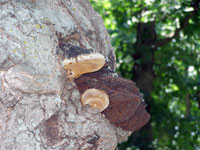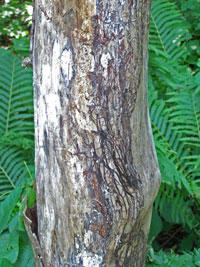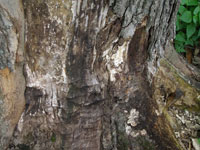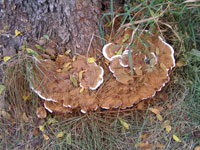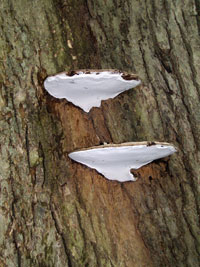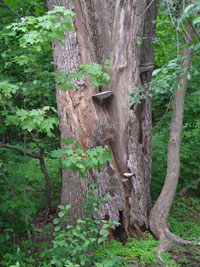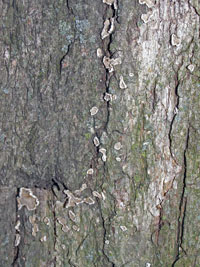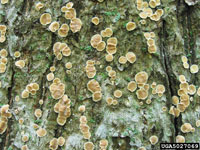Extension > Garden > Diagnose a problem > What's wrong with my plant? > Deciduous Trees > Oak > Fungi growing on trunk or branches
Oak > Trunk/Branches > Fungi growing on trunk or branches
1 of 4
Heart rot
Laetiporus sulphureus, Phellinus everhartii, Phellinus
igniarius, and others
- The canopy may show no symptoms or may have small yellowing leaves or dead branches depending on the extent of the trunk decay
- In cross section of the trunk, the wood at the center is discolored, soft, crumbling, stringy or spongy
- Fungal fruiting bodies arise along the stem, near a pruning wound, crack or other wound
- Many shapes and sizes of fungal fruiting bodies may be seen
- Phellinus spp. have hoof shaped fruiting bodies that are black on top and yellow brown underneath
- Laetiporus sp. have folds of yellow to bright orange fungal tissue arising in a clump
- More information on heart rot
2 of 4
Armillaria root rot
Armillaria gallica and Armillaria spp.
- Infected trees have poor growth, dead branches in the upper canopy, undersized and/or yellow leaves
- Flat white sheets of fungal mycelia (mycelia fans) grow between the bark and sapwood at the base of infected trees
- Thick black, shoestring-like fungus can sometimes be seen under the bark, around roots and in the soil around the base of the tree
- Wood is decayed, white, soft and spongy, and this may extend from the base of the tree well up into the trunk
- Trees frequently break or fall over in storms
- Clusters of honey-colored mushrooms may grow at the base of the tree in fall
- Twolined chestnut borers often found on trees affected by Armillaria root rot
- More information on Armillaria root rot
3 of 4
Ganoderma butt rot
Ganoderma applanatum
- Leaves are smaller in size and turn yellow earlier than normal
- Canopy appears thin with few leaves and multiple dead branches
- Fungal conks, a semicircle shelf fungi, can be found from the base of the tree up to 3 feet high on the trunk
- Conks are reddish brown and shiny on top, white and porous underneath, a rim of white may be visible on the edge of growing conks
- Infected wood at the base of the tree is white, soft, stringy or spongy
- Infected trees frequently break or fall over in storms
- More information on Ganoderma butt rot
4 of 4
Smooth Patch
Aleurodiscus spp. and Dendrothele spp.
- Sunken, relatively smooth, round to irregular area of bark on trunk or branches
- Affected bark is often lighter in color
- Small cream colored disks or saucer like fungal spore producing structures grow within affected area
- Has no affect on the overall health of the tree
- More information on Smooth Patch




